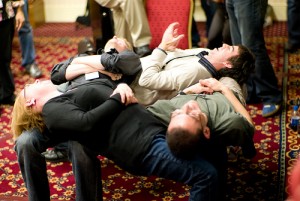Yesterday I covered 3 points for change leadership and project management:
1. You implement change everyday in your role as a project manager
2. You are in a leadership role
3. Major change requires strong leadership, starting with SEEING the “new” END
SEEING the “new” END becomes the VISION of what you and your team will be working to achieve. This is defined in detail with a good change management process. The vision should be aligned with goals of the project sponsor and customer. Having a clear, succinct statement that can be communicated to all involved addresses the uncertainty that people experience with change.
The change also defines what tasks will be stopped. For those efforts that will not be continued, acknowledge the effort and successes that have been achieved. Be empathetic towards those who will be moving on to other efforts.

For the team to work to believe in the new END, they need also need to TRUST you. You may already have earned that trust previously, which makes the situation a bit easier. To continue keeping their trust, have a communication plan.
The communication plan should include who is communicating what to who and when. Make the communication reliable and regular (possibly weekly in the beginning). Include what you know and what you don’t know – even if you don’t have all the details; say something. When there is an information gap, most people imagine all kinds of worse case scenarios which can increase the team’s anxiety. When there is less of a gap, there is less creativity, and less anxiety.
Provide a context for the change – is the change needed to reduce risk? To reduce costs or shorten the schedule?
Having a rough timeline on what will change and when something will be known is also useful. With a timeline, you are setting expectations on when additional details will be available. The team will then focus more on the future, rather than wallowing in the present. Work on minimizing the surprises, since surprises break down trust and can build resentment.
Communicate with passion and conviction so that the vision of the future can connect the mind and hearts of the team. Building trust to those you lead by being reliable, truthful, caring, and competent.
The key point for today: Communicate with care and conviction during times of uncertainty in order to build trust between you and your team.
Do you remember examples of this type of leadership behavior during a particularly difficult time? If not, do you think these type of actions would have helped make the change less stressful?

Great points. The communication should also be as open and honest as possible.
I started a weekly 15-minute stand-up with the whole team to review the highlights of what happened last week and what activities are going on this week, both programmatic and technical. There are multiple project teams within the project that have weekly tag-ups, but this is more of an all-hands discussion. The culture has been to only have quarterly all-hands up until now. Having just taken over a large team and being in an acting role it’s been a little rough, but I’m hoping that gets better as we move forward through the changes together.
Josh Nankivel
pmStudent.com